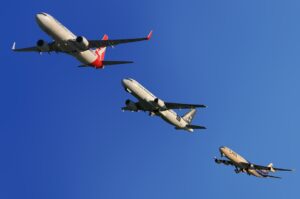PESTEL analysis of the aviation (airline) industry
This detailed PESTEL analysis of the aviation (airline) industry aims to examine some of the macro factors that impact on the airline industry in a number of countries, notably the USA, the UK, Canada, Australia, China, and India. The global airline industry is really enormous and plays an important role in global trades. However, it is worth noting that it is currently going through some enormous challenges as well.
Political factors examined in PESTEL analysis of the aviation (airline) industry
Political stability is essential for the airline industry to thrive. Geo-political crisis and trade disputes may impact on it badly. For example, the US sanctions may ban some airlines from flying to certain destinations.
Likewise, many airlines in the past, had reduced or cut their services to and from some countries, particularly Hong Kong due to political unrest that resulted in declining passenger numbers and unprofitable routes.
The will of the governments around the world impacts of the development of the airline industry. Many countries are building new airports and extending the existing ones to handle more travellers better. For instance, consider China’s mega new airport ‘the Daxing International Airport’ in this regard that has cost the country around $11 billion.
Likewise, India has recently opened or started building a number of airports e.g. Jewar Airport, Purandar Airport, Orvakal Airport, Mopa Airport, Navi Mumbai International Airport, Kannur International Airport, Sabarimala Airport, and Rourkela Airport. Most of the major commercial airports in the UK have plans to expand with a view to doubling the number of passengers by the end 2023.
However, though the USA is one of the global leaders in transportation and infrastructure innovation, Denver International Airport was the last new major airport built in the country over 25 years ago. It should be mentioned that US has over 19,000 private, public, and international airports (Carlier, 2023).

Economic factors examined in PESTEL analysis of the aviation (airline) industry
Mazareanu (2022) reports that the global aviation industry was valued around $359.3 billion in 2020 which is far lower than the previous year. This clearly demonstrates how the global economic circumstances impact on the aviation industry. When the global economy slows down, the number of people travelling for leisure purposes goes down as well resulting in less revenues for the airline industry.
Fluctuations in interest rates and exchange rates can affect the global aviation industry. High interest rates can make it more expensive for airlines to finance new aircraft or invest in infrastructure, while currency fluctuations can impact the costs of fuel, labour, and other inputs.
In addition, exchange rate volatility can influence both the demand for international air travel and the competitiveness of domestic airlines in attracting foreign passengers.
As finical positions of different demographics vary, so vary the services and types of airlines. For example, for luxury travels around the world, many passengers will perhaps go for Singapore airlines, Emirates airline, and the American airlines.
Likewise, some of the airlines that offer low-frills and affordable prices are easyJet and Ryanair in Europe, Swoop in Canada, Spirit Airlines, Frontier Airlines, and JetBlue Airways in the USA, and Jetstar in Australia. In fact, Malaysian airline Air Asia was named the best low-cost airline and Qatar Airways was named the best airline in the world in 2022 (Skytrax, 2023).
Social factors examined in PESTEL analysis of the aviation (airline) industry
Exploring social factors is the next stage in the PESTEL analysis of the aviation (airline industry). Global airline industry has created social values as many industries are supported by it and generate profits from it.
For instance, it supports around 87.7 million jobs around the world, either directly within it or, supported through its supply chain. Around 11.3 million people work in the aviation industry directly (Career in Aerospace, 2023).
Perception of many people about the airline industry has changed over the years. This industry is now seen as safer and convenient. Though it is going through a challenging time, many people consider it an industry where masses can pursue their careers and fulfil their dreams.
Consumer preferences play a crucial role in shaping the aviation industry, as airlines must constantly adapt to meet changing customer expectations and remain competitive. Today’s travellers are increasingly seeking personalised and seamless travel experiences, driving airlines to invest in innovative solutions that enhance the customer journey.
Sustainability is another area where consumer preferences are increasingly influencing the aviation industry. As environmental concerns become more prominent, travellers are seeking more eco-friendly options, leading airlines to prioritise sustainability initiatives and communicate their environmental efforts to customers.
Technological factors examined in PESTEL analysis of the aviation (airline) industry
Certainly, without technology, the aviation industry cannot function for a second! In fact, introducing commercial airline flights was one of the greatest technological achievements of the last century.
However, many analysists argue that the use of technology in aviation industry is somewhat limited to the development and the operations of the airlines. More innovations are indeed needed in the ticketing, front office, and customer facing functions.
The global aviation industry has made a very good use of social media to reach out the target audience. Technology has also been used to make the industry safer, more efficient, and eco-friendly.
However, the development of technology may reduce the demand for the airline industry in the future as well. For instance, many companies and government departments around the world are using Zoom, MS Teams, and other similar technologies to conduct meetings remotely instead of flying down to the meeting venues. This will certainly reduce the demand for the business class for many airlines.
A notable trend is the ongoing research and development of more fuel-efficient aircraft and alternative propulsion systems. As fuel costs represent a significant portion of airlines’ operating expenses, finding ways to reduce fuel consumption is a top priority for the industry.
Another significant trend is the increasing use of autonomous and remotely piloted aircraft. These technologies have the potential to reduce human error and enhance safety while also improving efficiency and reducing costs.
Moreover, the increasing availability of data and machine learning capabilities should enable airlines to make more informed decisions, leading to better operational performance and increased customer satisfaction.
Environmental factors examined in PESTEL analysis of the aviation (airline) industry
The aviation industry has been blamed for being a big contributor to global warming. It is responsible for around 5% of global warming which causes a huge public concern. Therefore, it should explore ways to reduce its impact on the environment. It is worth mentioning that solar powered, electric, and zero-emission planes are some of the ideas the industry is exploring to be more environmentally friendly.
Noise pollution is another environmental concern for the aviation industry, particularly for communities located near airports. To address this issue, aircraft manufacturers are working on new designs that produce less noise, while airports are implementing measures such as noise abatement procedures and land-use planning to minimize noise impacts on surrounding areas.
Legal factors examined in PESTEL analysis of the aviation (airline) industry
The aviation industry is widely impacted by a number of rules and regulations. For instance, Canada has considerable restrictions on foreign ownership of Canadian airlines which makes it a difficult place to start an airline. The UK has a number of Acts governing the aviation industry e.g. Civil Aviation Act 1982, the Operation of Air Services in the Community Regulations 2009, and Civil Aviation Act 2006.
The Airline Deregulation Act 1978 in the USA lifted the federal government’s control on the aviation industry which resulted in increased number of flights, increased number of passengers, and decreased fares.
Summary of PESTEL analysis of the aviation (airline) industry
Certainly, the global aviation industry is a dynamic and complex ecosystem shaped by various factors, including economic trends, technological advancements, environmental concerns, government regulations, global politics, consumer preferences, and global events and crises. To succeed in this highly competitive industry, aviation industry stakeholders must stay informed about these factors and adapt their strategies and operations accordingly.
The global aviation industry is highly susceptible to the effects of global events and crises, which can cause significant disruptions to air travel and have long-lasting impacts on the sector. Examples of such events include natural disasters, political instabilities, wars, and economic crises.
In the face of such events, it is crucial for aviation industry stakeholders to be agile and resilient, adapting their strategies and operations to navigate the challenges and seize opportunities that may arise.
We hope the article ‘PESTEL analysis of the aviation (airline) industry’ has been helpful. You may also like reading PESTEL analysis of the fashion retail industry in the UK. Other relevant articles for you are:
SWOT analysis of the USA’s Information Technology (IT) industry
Porter’s five forces analysis of the UK supermarket industry
Last update: 15 May 2023
References:
Career in Aerospace (2023) Employment in the Aviation Sector, available at: https://www.careersinaerospace.com/employment-in-aviation/ (accessed 10 May 2023)
Carlier, M. (2023) How many airports are in the U.S.? https://www.statista.com/statistics/183496/number-of-airports-in-the-united-states-since-1990/ (accessed 15 May 2023)
Mazareanu, E. (2022) Market size of the airline industry worldwide, available at: https://www.statista.com/statistics/1110342/market-size-airline-industry-worldwide/ (accessed 15 May 2023)
Skytrax (2023) World’s Best Low-Cost Airlines, available at: https://www.worldairlineawards.com/worlds-best-low-cost-airlines-2022/ (accessed 15 May 2023)
Author: M Rahman
M Rahman writes extensively online and offline with an emphasis on business management, marketing, and tourism. He is a lecturer in Management and Marketing. He holds an MSc in Tourism & Hospitality from the University of Sunderland. Also, graduated from Leeds Metropolitan University with a BA in Business & Management Studies and completed a DTLLS (Diploma in Teaching in the Life-Long Learning Sector) from London South Bank University.



